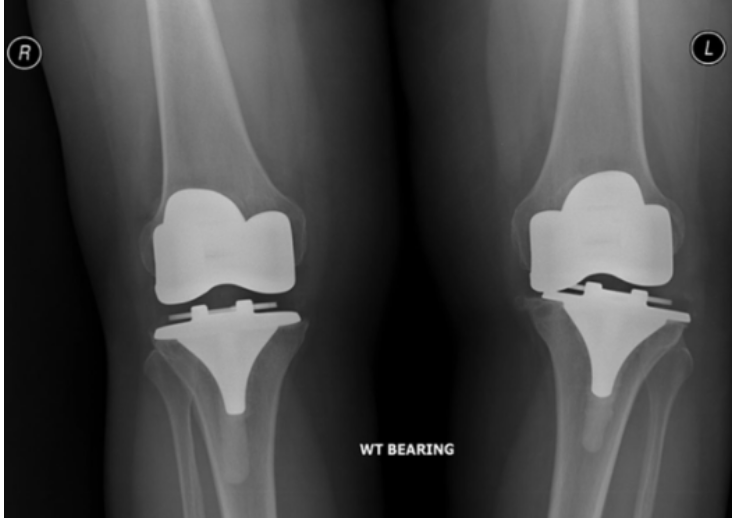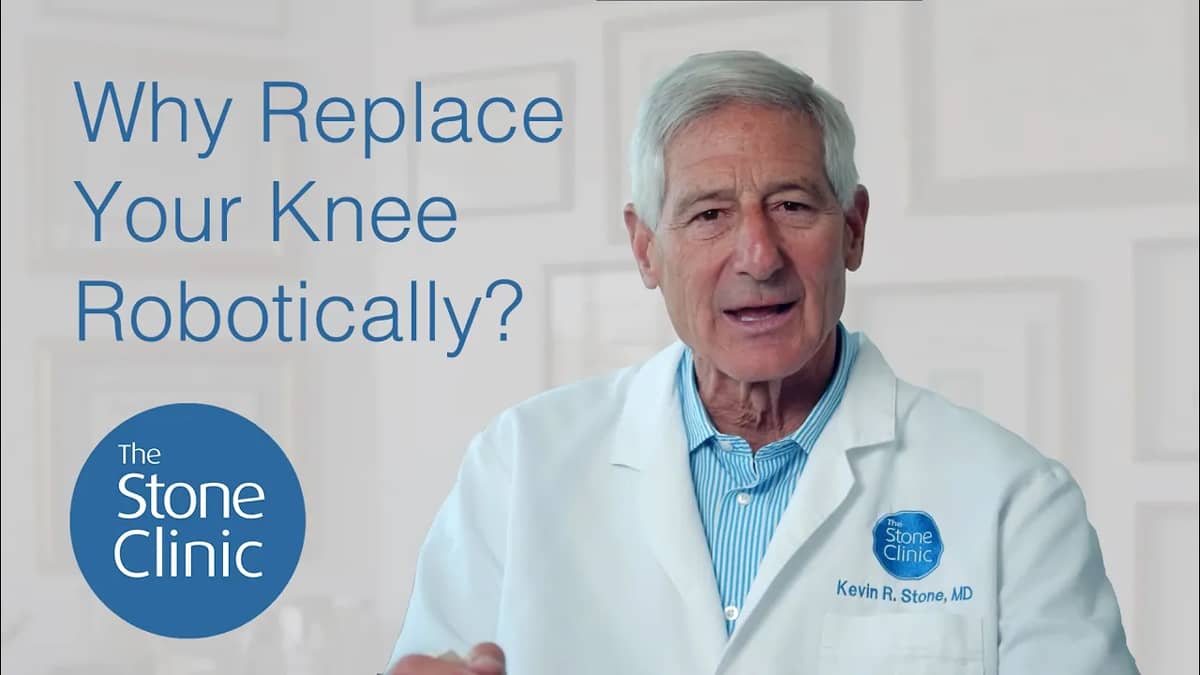Failed Total Knee Replacements
Arthritic knees, with bone-on-bone pain, have benefited tremendously from artificial knee replacements. These replacements, however, sometimes fail. Why so often, and what to do?

The bones of the knee joint are covered by a thin layer of articular cartilage, connected by ligaments, and surrounded by a joint lining called synovium. In cases of both traumatic injury and osteoarthritis, each of these three components is damaged and/or diseased. When novel treatments (such as injections with growth factors and lubricants, replacement of the meniscus and ligaments, and articular cartilage regeneration techniques) have been exhausted, artificial joint replacement is often undertaken. About 650,000 total knee joint replacements are performed in the US each year.
Traditionally, and still most commonly, the arthritic joint is exposed at surgery. Large bone cuts are made, using handheld guides, to remove the deformed arthritic bone and line up the femur directly over the tibia. The side ligaments are then balanced. This can be done by (1) adjusting the angle of the bony cuts to provide more or less tension on each ligament, or (2) partially cutting (releasing) the ligaments to achieve an equal balance of the inside and outside of the joint. The metal joint components are then cemented onto the bony surfaces. The undersurface of the kneecap (patella) is usually cut with a hand guide and a metal and plastic button cemented into place.
What could possibly go wrong? It turns out, everything.
When we see failed total joints due to loosening, laxity of the joint, or pain, we investigate the causes. Loosening is caused by a breakdown of the cement to the bone interface. In the past, people were told that,to preserve the lifespan of the cemented total knee, they had to avoid active sports. Unfortunately, this led to a weakening of the muscles that normally protect the knee and an acceleration of the natural bone loss that occurs with aging and can only be stopped by resistance exercise. The weakened bone led to a faster breakdown of the bone cement interface.
Laxity of the joint, meaning abnormally loose ligaments, is also a common finding. This is most frequently due to a misalignment of the joint components, or a mismanagement of the ligaments at the time of surgery. The manual testing of the ligament stability at the time of surgery is just too crude and too variable to get the balance right every time.
Joint pain is commonly due to a combination of all these errors as well as a failure of the rehabilitation program. Every patient who comes into an orthopedic clinic with a severely arthritic knee also has substantial limitations of multiple joint motions and weak musculature. This presents not just in the leg, but also in the core, and by gait that has been compromised for years. We often see patients who, after total knee replacement, were left to rehab their knee on their own. This should never be allowed to happen. A post-op rehabilitation program that focuses on all of these deficits and helps return the patient “fitter, faster and stronger than they have been in years,” is the only path to avoiding the lifelong deficits induced by arthritis.
Solutions to the dilemma of failed total joints do exist. First, exhausting all biologic reconstruction steps before proceeding to an artificial joint often makes sense, except for cases where clear bone-on-bone is found in multiple parts of the joint. When just one part shows bone-on-bone, a partial joint replacement is most often preferred. It requires less surgery, leaves the knee feeling more normal, has a better range of motion, and can be revised with a part or full replacement if the arthritis progresses.
If a full knee replacement is indicated, preplanning the placement of the knee components is crucial. We do this with 3D computerized technology. Based on cat scan (CT) models of the patient’s knee, using the MAKO robotic arm, precise cuts can be made—sparing much of the bone. These cuts are so accurate that unique metal implants with bony ingrowth undersurfaces can be tightly fit. The patient’s own bone grows into the implant, eliminating the need for cement. There is excellent data suggesting the kneecap itself can be left untouched, thus eliminating the complications that often arise from resurfacing it.
We perform these uncemented robotically-guided types of knee replacement as an outpatient procedure. It is followed by immediate weight-bearing, and the initiation of two-hour-a-day rehabilitation and strengthening programs, beginning in our clinic the day after surgery. It usually takes about three months of daily guided exercise and manual therapy to achieve a full recovery with a return to sports. Since there is no cement, we do not limit our patients’ sporting activities. In fact, we encourage them to do as much as they reasonably can to strengthen muscles and bone through active exercise.
While problems can arise with any surgery, the advances in total knee procedures can avoid the most common causes of failure. We want you to use your joints for as long as you live and to live like you will live forever.
You may not need an artificial knee replacement. Often we find that patients have been told they need a total knee replacement when they could, in fact, benefit from a less invasive procedure. Our BioKnee® program biologically reconstructs the knee joint without the use of artificial implants. Head here to learn about our alternative to knee replacement.
How Dr. Stone Performs Knee Replacement Surgery at the Robotic Joint Center
Learn how recent advancements in robotic-assisted surgery technology give Dr. Stone unparalleled accuracy in placing knee replacement implants, allowing for a quicker recovery time, better range of motion, less pain medication, and greater durability for demanding activities.

